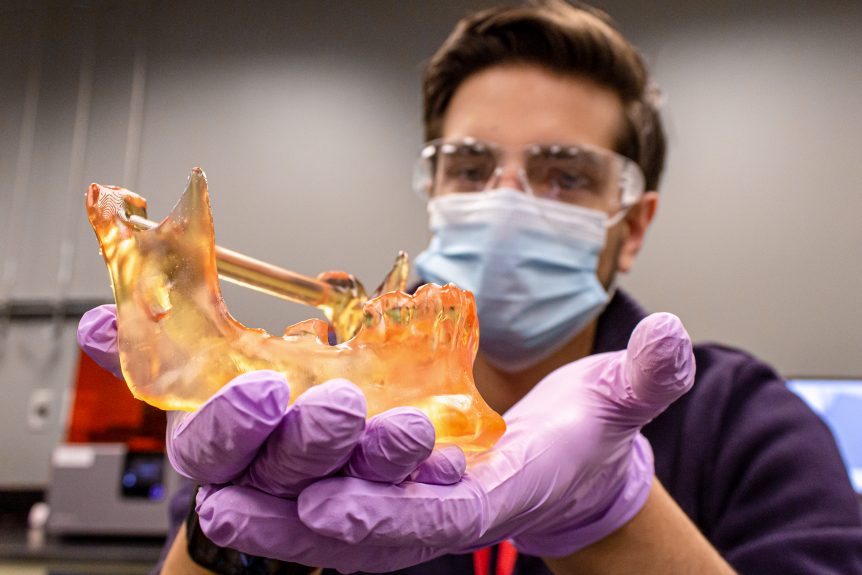A newly formed, interdisciplinary team of researchers at The Ohio State University’s Nanotech West Laboratory is utilizing 3D printing to find innovative engineering solutions for real-world needs in clinical medicine.
Current 3D printing technologies at Ohio State allow experts in the recently established Medical Modeling, Materials and Manufacturing Lab (M4 Lab) to quickly create complex geometries and shapes to be utilized for patient-specific applications.
The new clinical 3D printing and engineering facility will meet specific needs of the medical community, while being managed and operated by biomedical engineering and clinical experts with firsthand experience commercializing medical devices.
“The goal of the M4 Lab is to support the life-saving efforts of Ohio State’s medical professionals and faculty by stimulating and centralizing research innovation around bioengineering, medical device development and clinical 3D printing,” said M4 Lab Program Manager Mary Hoffman Pancake, who also serves as program manager at the Center for Design and Manufacturing Excellence (CDME).
The M4 Lab is a hub for innovative approaches to health care and advanced manufacturing techniques that brings together experts from the College of Medicine’s Department of Otolaryngology, the College of Engineering’s CDME and the Institute for Materials Research (IMR) under one roof at the Nanotech West Lab user facility on West Campus.

And researchers at the M4 Lab have hit the ground running.
In November, M4 Lab Director Kyle VanKoevering, M.D., an assistant professor in the Department of Otolaryngology – Head and Neck Surgery at Ohio State who treats patients at The Ohio State University Comprehensive Cancer Center – Arthur G. James Cancer Hospital and Richard J. Solove Research Institute, led M4’s first project to create a 3D model of a patient’s mandible, or lower jawbone. The team used imaging from a CT scan to create an exact replica of the 3D anatomy of the patient’s jawbone. That model was soon used in the operating room to successfully facilitate the reconstruction of that patient’s jaw after the removal of a segment of bone.
Since that initial project, the lab has 3D printed 2 to 3 patient-specific models per week that have been used in the operating room, as well as a customized airway stent for a patient with a tracheal obstruction.
“As we think about personalizing medicine, we want to customize each reconstruction or make a special device that is custom-fitted to a patient’s specific anatomy,” said VanKoevering, who specializes in tumors and cancers of the head and neck at the OSUCCC – James. “3D printing allows us to do that.”
The lab’s advanced manufacturing capabilities are enabled by an array of 3D printers, as well as a team of engineers with medical device experience gained from previous projects at Ohio State’s manufacturing hub on West Campus, said M4 Lab Manager Corinne Macnichol, a lead engineer at CDME. Different types of 3D printers housed at the M4 Lab enable various fabrication methods, including stereolithography, fused deposition modeling, and silicone casting and processing.

On top of research and clinical support activities, the lab will be used as an experiential education platform for undergraduate research assistants, providing students with real-world experience and on-the-job training that will position them as top candidates for medical device company hires. Additionally, postdoctoral researchers, medical students and residents from across medical and engineering disciplines can collaborate there to create innovative health care solutions.
The convergence of medicine, manufacturing, and other engineering and materials-related research areas that enabled the M4 Lab began earlier, in 2020, with the rise of the COVID-19 pandemic.
IMR led a project with CDME and the Infectious Diseases Institute to rapidly manufacture and distribute more than half a million nasopharyngeal swabs during a critical shortage of testing supplies in Ohio. The collaboration brought together researchers and innovators from across the university, from the College of Engineering to the College of Medicine and beyond.
The M4 Lab builds on the collaborative, multidisciplinary foundation established by that massive clinical 3D printing endeavor and will continue pursuing innovative approaches to advance health and well-being in our society.
“At our core, IMR is an institute of centers, many of which resulted from developing labs just like the M4,” IMR Director of Innovation Jay Sayre said. “We are excited to support this new lab at Nanotech West and enable its success by further strengthening our relationship with CDME and building on our recent collaborations with the College of Medicine.”
Story by Mike Huson, IMR Public Relations
Contact: huson.4@osu.edu
Follow: @OhioStateIMR
Reposted with permission from https://imr.osu.edu/ohio-state-m4-lab-opens/
